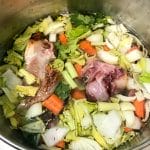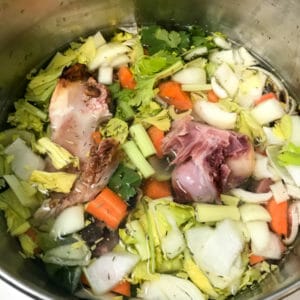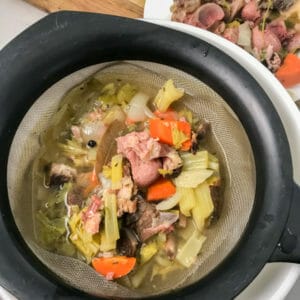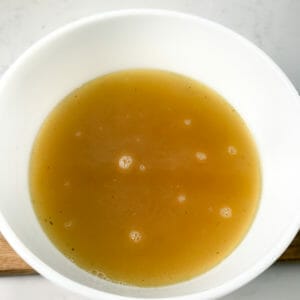How to Make Ham Stock Using Ham Bones
Making ham stock is a great way to use leftover ham bones after a tasty ham dinner. Simply toss the bones and few aromatics like celery, onions and carrots in a large soup pot and let it simmer for a while.
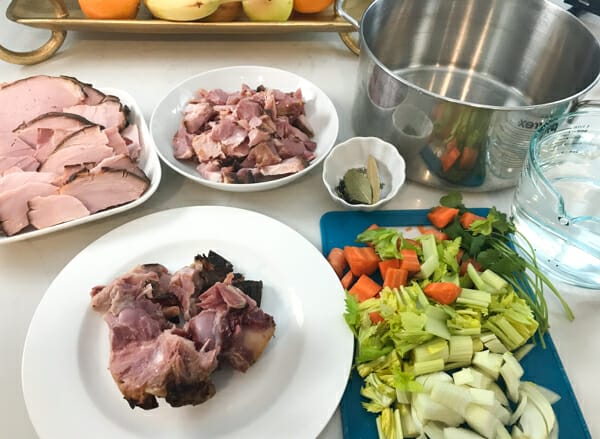
Also Read: Homemade Vegetable Soup Stock, What You Need to Know When Making Soup, How to Make Stock from Cooked Chicken, How to Make Stock from Raw Chicken
Before you make stock, get as much meat as you can off the bones. I start by slicing as many nice large slices as I can off the ham – like you see on the top left in the photo above. We use these nice slices for sandwiches or leftovers. When I can’t cut any more big slices, I use a small knife and trim off as many little pieces that I can – like you see in the top middle of the photo. We use these little pieces in the final soup that we make. By removing them before you simmer the ham bone, these pieces will remain flavorful and stay nice and tender. Once I’ve finished getting all the meat I can off the bone, I crack the bone at the knuckle, gather my veggies and herbs and get set to make stock as outlined in the recipe below.
How to Make Ham Stock with Leftover Ham Bones & Veggies
How to Make Ham Soup Stock with Leftover Ham Bones and Vegetables
Ingredients
- 1-3 large cooked ham bones & trimmed bits
- 1 large onion roughly chopped
- 2 celery ribs & leaves roughly chopped
- 2 carrots roughly chopped
- any vegetable peelings & ends if available*
- leftover tomato salsa, sauce or juice if available**
- any vegetables hiding in the back of the fridge if available***
- 2-3 sprigs fresh thyme 1 tsp dried
- 2 bay leaves
- 1/2 cup chopped parsley leaves & stems
- 1 tbsp vinegar
- 1 tsp salt
- 5 black pepper kernels
- 4-6 cups water just enough to cover everything
Instructions
- After your ham dinner is finished, slice off as many lovely, large slices as you can from your ham. Save the nice large slices for sandwiches or leftovers. Then use a smaller knife and remove as many little pieces of ham as you can. Store these these smaller pieces in the fridge until your ready to make your final soup. Place any pieces that don't appeal to you into the soup pot. If there are pieces that are just fat, toss them in the garbage as they will leave your stock too fatty and you'll have to skim your stock later.
- Once you've picked off all the good bits from the ham bones, place them in the pot with any of the other trimmings. If you'd like, you can crack or split the bones at the joints if possible to get even greater flavor and to get the most gelatin. It's okay to skip this step and toss in the whole bone as is if you prefer.
- Add vegetables,any leftover sauces, herbs, vinegar and spices.
- Cover with 4 to 6 cups cold water so that everything is covered by no more than one inch of water. Too much water will prevent good flavor from developing.
- Bring to a boil, reduce heat immediately to a low simmer. Simmer for 2 hours.
- Remove from heat and carefully remove and discard large pieces of vegetables or bones from the pot. Pour stock through a fine mesh strainer into a clean pot or bowl.
- Cool and store in a refrigerator, preferably over night.
- When the stock has cooled, skim off any fat that has collected on the top with a spoon.
- Heat and use your stock as desired. Adjust seasoning accordingly.
- Makes 4-6 cups of stock
Notes
**Tomato products will change the overall flavor of your stock, but if you’re planning to make soup with tomato flavoring go for it.
***Avoid using strong tasting vegetables so they don’t overpower the flavor of your stock (beets, broccoli, fennel, asparagus, rutabaga, parsnips, cabbage, cauliflower etc.)
Starchy veggies like potatoes, sweet potatoes, winter squash will make your stock cloudy.
****Make this in a crock pot. Simply toss everything in a crock-pot, turn to low and cook for 8-10 hours.
Nutrition Facts (per serving)
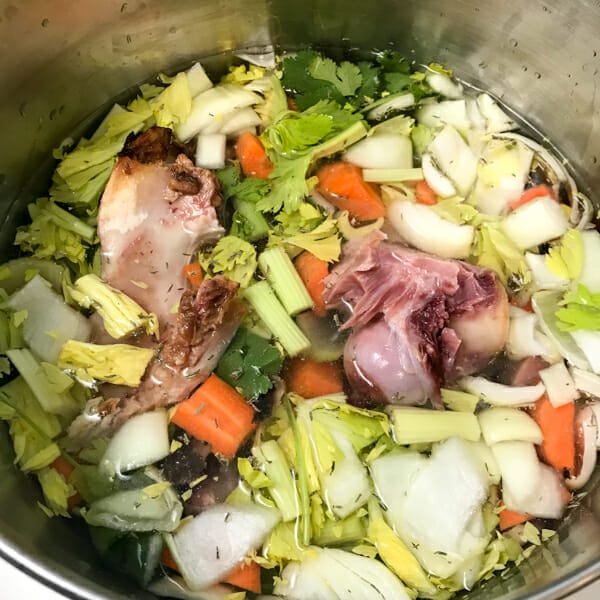
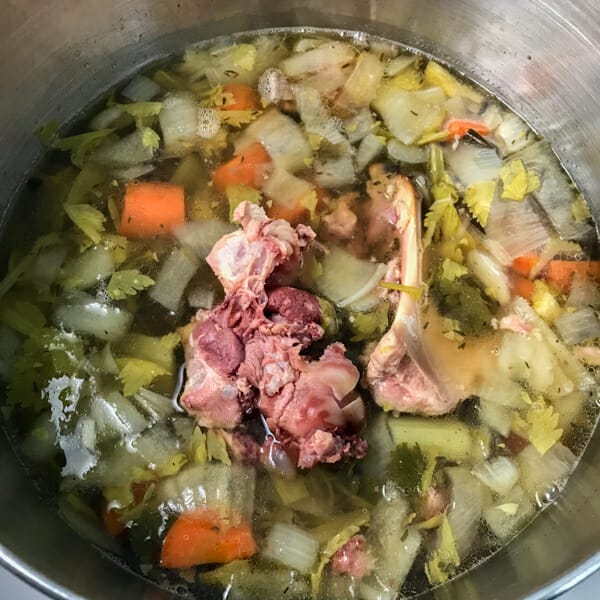

How Long Will My Soup Stock Last?
- Keep your stock in the refrigerator for up to 4 days. At that point, use it or freeze it!
- Freeze your stock in commonly used amounts (eg. 1 or 2 cups) for up to 6 months. It will be safe to consume even longer than that, but will start to lose some flavor. Remember to leave at least 1 inch of headspace between the top of the soup and the lid of the container. When it freezes, the stock will expand.
- If you wish, you can safely can your soup stock in a pressure canner as recommended by the National Center for Home Food Preservation.

All the best soups start with a GREAT base.
Learn top tips and get 5 recipes for the best and only soup stocks you’ll ever need. Master these skills and these recipes and you’ll boost your overall cooking skills. These stocks are the foundation of soups, stews, sauces, pasta and rice dishes. $9 pdf (ebook) – download & save to all your favorite devices.
How to Use Finished Ham Stock?
You can use your ham stock in just about any recipe that calls for soup stock. Naturally, because it will have some ham flavor, it is ideal to use in soup, sauces or dishes that use pork or ham. Use it for ham and bean soup, split pea soup, borscht or this ham and bean soup that I’ll be sharing in the next little while.

For stock made with leftover chicken or turkey bones click here: Chicken Stock
For broth made with raw chicken pieces click here: Chicken Broth from Raw Pieces
For stock made with just vegetables click here: Homemade Vegetable Broth
I’d love to see what you’re making! Take a photo and tag #getgettys so I can see it and like it!
Getty Stewart is a Professional Home Economist, speaker, frequent media guest and writer dedicated to putting good food on tables and agendas. She is the author of several recipe books on enjoying and preserving fruit, Founder of Fruit Share, a mom and veggie gardener. Sign up to get articles by Getty delivered to your inbox. You’ll get recipes, practical tips and great food information like this.


